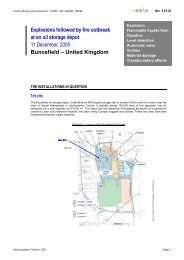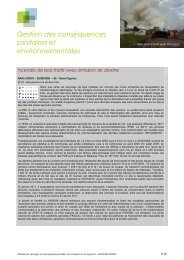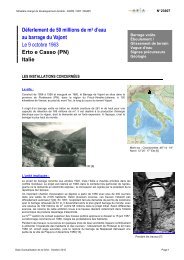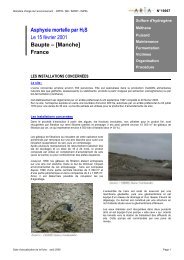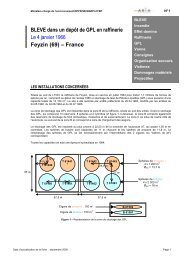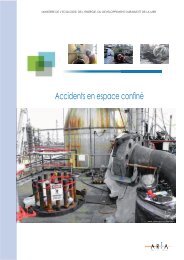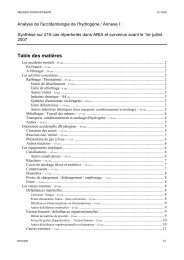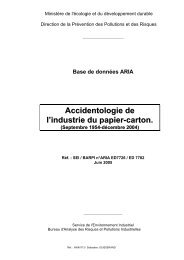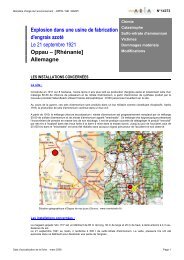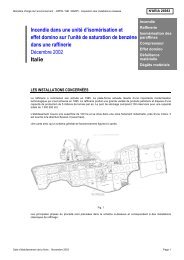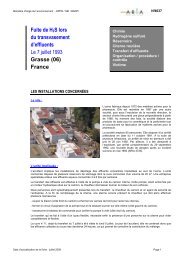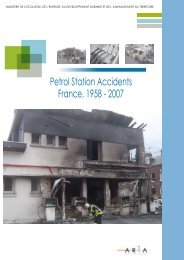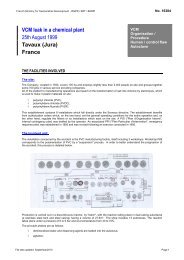Explosion in a sulphuric acid tank 26th November 2005 Pierre ... - Aria
Explosion in a sulphuric acid tank 26th November 2005 Pierre ... - Aria
Explosion in a sulphuric acid tank 26th November 2005 Pierre ... - Aria
Create successful ePaper yourself
Turn your PDF publications into a flip-book with our unique Google optimized e-Paper software.
M<strong>in</strong>istry <strong>in</strong> charge of the environment - DPPR / SEI / BARPI N° 31082<br />
<strong>Explosion</strong> <strong>in</strong> a <strong>sulphuric</strong> <strong>acid</strong> <strong>tank</strong><br />
26 th <strong>November</strong> <strong>2005</strong><br />
<strong>Pierre</strong>-Bénite [Rhône]<br />
France<br />
THE INSTALLATIONS CONCERNED<br />
The site :<br />
The plant, classified high level Seveso (AS), synthesises some forty substances pr<strong>in</strong>cipally derived from <strong>sulphuric</strong>,<br />
hydrochloric and hydrofluroric <strong>acid</strong>s produced on the site.<br />
The <strong>in</strong>stallation concerned<br />
Chemistry<br />
Hydrogen<br />
Corrosion iron / <strong>acid</strong><br />
Corrosion by pitt<strong>in</strong>g<br />
Heat exchanger<br />
Anti legionellosis treatment<br />
Organization / modifications<br />
The “<strong>sulphuric</strong> <strong>acid</strong>” unit produces 99.2 % <strong>acid</strong> by absorption of SO3 <strong>in</strong> two columns. The SO3 itself is obta<strong>in</strong>ed by<br />
catalytic oxidation of SO2 produced by the combustion of sulphur (contact process).<br />
For each column, the heat generation from the absorption reaction is compensated by a cool<strong>in</strong>g system known as the<br />
“circulat<strong>in</strong>g loop” us<strong>in</strong>g spiral heat exchangers fed by the cool<strong>in</strong>g water circuit.<br />
The <strong>sulphuric</strong> <strong>acid</strong> is evacuated by regulation of the level of the column towards storage <strong>tank</strong>s by pipes pierc<strong>in</strong>g the<br />
circulat<strong>in</strong>g loop.<br />
Several <strong>tank</strong>s with a capacity of 1,500 t each allow for the storage of the 99.2 % <strong>acid</strong> produced. They are fed via access<br />
po<strong>in</strong>ts on the conically shaped dome from the production l<strong>in</strong>es. They also have, at the bottom of the <strong>tank</strong>, a decantation<br />
pipe and a recirculation pipe as well as a vent high up on the dome to allow ventilation of the gas phases via a collector<br />
and an <strong>acid</strong> dryer.<br />
Date of updat<strong>in</strong>g the report: <strong>November</strong> 2007 Page 1
M<strong>in</strong>istry <strong>in</strong> charge of the environment - DPPR / SEI / BARPI - IMPEL N° 31082<br />
THE ACCIDENT, THE SEQUENCE OF EVENTS, ITS EFFECTS AND CONSEQUENCES<br />
The accident<br />
S<strong>in</strong>ce 21/10,the <strong>sulphuric</strong> <strong>acid</strong> unit had been halted, the <strong>acid</strong><br />
stocks were at full capacity level.<br />
On 22/11, the restart<strong>in</strong>g of the <strong>in</strong>stallations was <strong>in</strong>terrupted dur<strong>in</strong>g<br />
the preparatory phase, follow<strong>in</strong>g a leak <strong>in</strong> the water/<strong>acid</strong> heat<br />
exchanger of the 1 st absorption column. This leak, detected by the<br />
ris<strong>in</strong>g temperature on the coil and on the <strong>acid</strong> exit pipes, required<br />
the replacement of the exchanger, which was completed on 24/11.<br />
On the morn<strong>in</strong>g of 25/11, the analysis of the <strong>acid</strong> strength on the<br />
1 st column showed an abnormally low level at the base of the<br />
column (84.3 %). Believ<strong>in</strong>g that this was a consequence of the<br />
previous <strong>in</strong>cident, the operator corrected the anomaly by the<br />
addition of oleum to the column and decantation of <strong>acid</strong> to the<br />
storage <strong>tank</strong>s to ma<strong>in</strong>ta<strong>in</strong> a constant level <strong>in</strong> the column.<br />
Progressive <strong>in</strong>creases <strong>in</strong> strength were observed: 84.3 %, 88 %<br />
then 91.3 %.<br />
Page 2 Date of updat<strong>in</strong>g the report: <strong>November</strong> 2007<br />
Replacement of the exchanger<br />
Source : exploitant<br />
On 26/11 at midnight, the strength of 55 % analysed on the coil of the 1 st tower <strong>in</strong>dicates an <strong>in</strong>filtration of water <strong>in</strong>to the<br />
<strong>in</strong>stallation. The sample taken was of a greenish colour, <strong>in</strong>dicat<strong>in</strong>g the corrosion of equipment. A second heat exchanger<br />
had already sprung a leak on the previous day without this hav<strong>in</strong>g been detected on account of the addition of the oleum.<br />
The water/<strong>acid</strong> and oleum/<strong>acid</strong> were both <strong>in</strong> effect heat generat<strong>in</strong>g.<br />
At 1 a.m., restrictions were applied to undertake further checks ; the water entry valves were closed as well as the return<br />
valve to the column of the circulat<strong>in</strong>g loop <strong>in</strong> order to favour the flow to the storage <strong>tank</strong>.<br />
At 2, a leak appeared on the flange of the circulation pump.<br />
At 4:30, the leak became more serious ; the viscosity of the product alerted the personnel who conducted tests with<br />
litmus paper, this <strong>in</strong>dicated that the substance released was neutral. The pump for transmission to the storage <strong>tank</strong> was<br />
halted.<br />
At 5:30, follow<strong>in</strong>g the raise of the level <strong>in</strong> the 1 st tower, this was emptied <strong>in</strong>to the neutralisation trench. The halt<strong>in</strong>g of<br />
the cool<strong>in</strong>g water pump caused the rise <strong>in</strong> level to cease.<br />
At 10:30, the storage <strong>tank</strong> contents were stirred to allow for a measurement of the <strong>acid</strong> strength and a decision as to the<br />
measures to be taken.<br />
At 11, the <strong>acid</strong> strength at the base of the <strong>tank</strong> was measured at 89 % with a temperature 27 °C.<br />
At 11:30,the strength reached 88 % with a temperature of 27°C.<br />
At 11:43, an explosion was heard on the site : the dome of the<br />
storage <strong>tank</strong> was partly opened around the circumference (r<strong>in</strong>g diedome).<br />
Only a few fumeroles were observed on the right of the<br />
open<strong>in</strong>g on the dome.<br />
At 11:45, The POI (emergency plan) of the establishment was put<br />
<strong>in</strong>to effect ; the security personnel marked out the zone. No release<br />
or leakage of product was observed. The units us<strong>in</strong>g the 99.2 % <strong>acid</strong><br />
were halted to avoid movement of the <strong>tank</strong> (the open vent<strong>in</strong>g pipes<br />
could allow the entry of humidity), the bottom valves of the <strong>tank</strong> were<br />
closed. Dur<strong>in</strong>g the afternoon, plastic sheet<strong>in</strong>g was used to cover the<br />
vent<strong>in</strong>g pipes and the <strong>tank</strong> was slowly emptied <strong>in</strong>to the neutralisation<br />
trench.<br />
The dome of the storage <strong>tank</strong> is partly opened<br />
around the circumference.<br />
Source : exploitant
M<strong>in</strong>istry <strong>in</strong> charge of the environment - DPPR / SEI / BARPI N° 31082<br />
The consequences :<br />
No consequences were observed for the personnel nor the environment.<br />
Equipment above the <strong>tank</strong> was deformed or broken (<strong>acid</strong> entry pip<strong>in</strong>g from the factory,<br />
pipe towards the dryer from the other storage <strong>tank</strong>s, gangway, vapour pipe…).<br />
European scale of <strong>in</strong>dustrial accidents<br />
In us<strong>in</strong>g the scor<strong>in</strong>g rules of the 18 parameters of the scale officially adopted <strong>in</strong><br />
February 1994 by the Committee of Competent Authorities of the Member States for<br />
the application of the ‘SEVESO’, directive, tak<strong>in</strong>g <strong>in</strong>to account the available<br />
<strong>in</strong>formation, the accident can be characterised by the 4 follow<strong>in</strong>g <strong>in</strong>dices<br />
Parameters compos<strong>in</strong>g these <strong>in</strong>dices and correspond<strong>in</strong>g methods of calculation can be found at the follow<strong>in</strong>g address::<br />
http://www.aria.ecologie.gouv.fr<br />
Follow<strong>in</strong>g analyses of material damage to the <strong>in</strong>stallations, the operator estimated that a quantity of several dozen grams<br />
of hydrogen were at the orig<strong>in</strong> of the explosion, which corresponds to less than 0.02 % of the Seveso threshold for<br />
substances describes as “highly <strong>in</strong>flammable” (50 t) ; the <strong>in</strong>dex “dangerous materials released” on the European scaleis<br />
therefore 1 (parameter Q1).<br />
The absence of precise <strong>in</strong>formation on the economic consequences of the accident prevents us from know<strong>in</strong>g the level<br />
correspond<strong>in</strong>g to the European scale.<br />
ORIGIN, CAUSES AND CIRCONSTANCES OF THE ACCIDENT<br />
Orig<strong>in</strong> of the explosion :<br />
Material damage observed correspond to those result<strong>in</strong>g from a low powered explosion, which could be due:<br />
- to a hydrogen (H2) explosion l<strong>in</strong>ked to corrosion of steel by diluted <strong>acid</strong> result<strong>in</strong>g from the mixture of <strong>sulphuric</strong><br />
<strong>acid</strong> and water,<br />
- to a massive generation of water vapour l<strong>in</strong>ked to the heat generation from the water/<strong>acid</strong> mixture when the<br />
agitation <strong>in</strong> the <strong>tank</strong> was <strong>in</strong>itiated.<br />
This latter hypothesis was rapidly set aside on account of the temperatures measured at the base of the <strong>tank</strong> (27°C) and<br />
on the surface of the liquid (66°C) a few m<strong>in</strong>utes b efore the accident.<br />
The formation of a small quantity of hydrogen (of the order of several dozen grams) - a gas which requires very little<br />
energy for ignition, was the probable cause of the explosion. In the absence of movement <strong>in</strong> the reservoir between 4:30<br />
and 10:30, a zone of high concentration of H2 (10 % at a m<strong>in</strong>imum) could develop <strong>in</strong> the <strong>tank</strong>; its ignition (which requires<br />
very little energy, of the order of a few mJ) could result <strong>in</strong> an electrostatic phenomenon when the agitation process was<br />
<strong>in</strong>itiated.<br />
The primary cause of the accident was therefore the production of diluted <strong>acid</strong> which corroded the steel <strong>in</strong>terior<br />
of the <strong>tank</strong> while form<strong>in</strong>g hydrogen.<br />
Orig<strong>in</strong> of the dilution of the <strong>acid</strong> :<br />
Deformed gangway<br />
Source : exploitant<br />
The water supply not be<strong>in</strong>g suspect, the analysis of the causes of the accident was directed at the <strong>in</strong>ternal water<br />
tightness of the heat exchangers which equipped the circulat<strong>in</strong>g loop of the 1 st tower.<br />
Date of updat<strong>in</strong>g the report: <strong>November</strong> 2007 Page 3
M<strong>in</strong>istry <strong>in</strong> charge of the environment - DPPR / SEI / BARPI - IMPEL N° 31082<br />
Observations on site and analyses conducted on the metallurgical slices of the exchangers provided evidence of a<br />
phenomenon of corrosion by pitt<strong>in</strong>g (observation of pits of 3mm <strong>in</strong> depth) <strong>in</strong>itiated on the “water cool<strong>in</strong>g” side, around<br />
welds and on the ma<strong>in</strong>tenance covers of the metallic envelope (zone where the material is heavily stra<strong>in</strong> hardened).<br />
The sudden rapid corrosion which caused the pierc<strong>in</strong>g of the exchangers followed a flow of water onto the <strong>acid</strong> side, the<br />
heat generation of the reaction accelerat<strong>in</strong>g considerably the phenomenon (speed of several dozen mm/year).<br />
The dilute <strong>acid</strong> formed on the contact with the cool<strong>in</strong>g water was highly corrosive on the 316L sta<strong>in</strong>less steel of which<br />
the unit was constructed.<br />
Orig<strong>in</strong> of the pitt<strong>in</strong>g corrosion :<br />
This corrosion hav<strong>in</strong>g never been observed on this type of exchanger, <strong>in</strong> service for 25 years on the site, the accident<br />
can only be attributed to recent changes <strong>in</strong> the operat<strong>in</strong>g conditions.<br />
In fact, the usual anti-legionellosis treatment (biocide follow<strong>in</strong>g a bromide base) was replaced by a cont<strong>in</strong>uous treatment<br />
with sodium hypochlorite. This must be overdosed to ensure its effectiveness as a long-term biocide tak<strong>in</strong>g <strong>in</strong>to account<br />
also the pH over 8 of cool<strong>in</strong>g water, considerably <strong>in</strong>creas<strong>in</strong>g the oxidis<strong>in</strong>g power of the latter. Moreover, the lower<strong>in</strong>g of<br />
the speed of the flow of water follow<strong>in</strong>g the re<strong>in</strong><strong>in</strong>g <strong>in</strong> of the exchangers associated with the operation at a low regime <strong>in</strong><br />
the factory for a long period, caused an <strong>in</strong>crease <strong>in</strong> the temperature of the water which amplified the phenomenon:<br />
<strong>in</strong>creas<strong>in</strong>g the oxidis<strong>in</strong>g potential of the milieu and lower<strong>in</strong>g the temperature required for the pitt<strong>in</strong>g (between 15 and<br />
30°C for a chlor<strong>in</strong>e content 500 mg/L for the most s ensitive zones such as those affected by stra<strong>in</strong> harden<strong>in</strong>g or those<br />
affected thermally at the level of the welds).<br />
The pitt<strong>in</strong>g observed be<strong>in</strong>g almost exclusively on one side of the welds (the closest fo the passage of <strong>sulphuric</strong> <strong>acid</strong> and<br />
thus the warmest) this pitt<strong>in</strong>g began dur<strong>in</strong>g normal operation of the exchangers.<br />
THE STEPS TAKEN<br />
Several Measures were taken to avoid further <strong>in</strong>cidents of this k<strong>in</strong>d..<br />
Modification of the anti-legionellosis treatment of the cool<strong>in</strong>g water<br />
The treatment of the water with Javel was replaced by a non-oxidis<strong>in</strong>g biocide treatment associated with an <strong>in</strong>crease <strong>in</strong><br />
the doses of a bio-dispersant until the entry <strong>in</strong>to service of new heat exchangers.<br />
A cont<strong>in</strong>uous treatment with a mixture of chlor<strong>in</strong>e/brom<strong>in</strong>e gave the advantage of be<strong>in</strong>g effective <strong>in</strong> a basic milieu and not<br />
therefore need<strong>in</strong>g strong concentrations is under study.<br />
Page 4 Date of updat<strong>in</strong>g the report: <strong>November</strong> 2007<br />
Sta<strong>in</strong>less steels are<br />
particularly sensitive to<br />
corrosion by pitt<strong>in</strong>g <strong>in</strong> the<br />
presence of aqueous<br />
solutions charged with<br />
chlor<strong>in</strong>e, brom<strong>in</strong>e or<br />
particularly hydrochloric<br />
ions.. At the level of<br />
germ<strong>in</strong>ation, a l<strong>in</strong>k is<br />
established between<br />
unconnected zones which<br />
constitute small anodes<br />
where the metal is dissolved,<br />
and the rest of the surface<br />
where a cathode reaction is<br />
produced as shown (example<br />
with chlor<strong>in</strong>e ions).
M<strong>in</strong>istry <strong>in</strong> charge of the environment - DPPR / SEI / BARPI N° 31082<br />
Improvement of the detection of abnormalities <strong>in</strong> the water at arrival <strong>in</strong> the procedure<br />
An alarm l<strong>in</strong>ked temperature sensor is placed on the <strong>acid</strong> exit from each exchanger..<br />
Two titrimeters hav<strong>in</strong>g a wide measurement range (55 % à 100 %) were <strong>in</strong>stalled <strong>in</strong> each absorption column.<br />
Procedure for storage of <strong>acid</strong><br />
The flow of weak <strong>acid</strong> <strong>in</strong>to the reservoirs was prevented by:<br />
- <strong>in</strong>stallation of procedures and reflex actions on the handl<strong>in</strong>g of high temperature alarms and the handl<strong>in</strong>g of<br />
abnormally low concentrations.<br />
- Information of the personnel concern<strong>in</strong>g the new practices.<br />
THE LESSONS LEARNED<br />
The <strong>in</strong>itial cause of the accident which occurred at <strong>Pierre</strong>-Bénite lies <strong>in</strong> the modification of the operat<strong>in</strong>g conditions of the<br />
unit (anti-legionellosis treatment) almost a year beforehand. All modifications of procedure, even m<strong>in</strong>imal or on ancillary<br />
equipment or procedures can thus have an impact on the security of <strong>in</strong>stallations <strong>in</strong> the short or longer term. It is thus<br />
essential that all effects should be subject to profound study, that a follow up cover<strong>in</strong>g these modifications should be<br />
<strong>in</strong>cluded <strong>in</strong> the documentation cover<strong>in</strong>g the unit (plans, operat<strong>in</strong>g, security and ma<strong>in</strong>tenance check<strong>in</strong>g procedures…) and<br />
that the personnel be tra<strong>in</strong>ed accord<strong>in</strong>gly.<br />
On a more technical plane, the accident rem<strong>in</strong>ds us that iron, like most common metals (z<strong>in</strong>c, alum<strong>in</strong>ium) are attacked<br />
by dilute <strong>acid</strong>s <strong>in</strong>volv<strong>in</strong>g the emission of hydrogen, as shows the follow<strong>in</strong>g reaction:<br />
Fe + 2H + ↔ Fe 2+ + H2<br />
Tak<strong>in</strong>g <strong>in</strong>to account the extreme flammability of hydrogen on account of its very wide field of flammability (from 4% to<br />
75% <strong>in</strong> air) and the very low amount of energy required for ignition (0.02 mJ as aga<strong>in</strong>st 0.29 mJ for methane), the risk of<br />
a hydrogen explosion exists as soon as <strong>acid</strong> corrosion of metal of any scale is observed. In certa<strong>in</strong> cases, the flow of<br />
liquid aga<strong>in</strong>st a surface (friction) or a slight jolt can suffice to ignite the hydrogen<br />
A locally high concentration of hydrogen (above 4 % <strong>in</strong> air), for example <strong>in</strong> a dead zone or at the upper level of a volume,<br />
can thus create a risk, as illustrated by the explosion of hydrogen dur<strong>in</strong>g work undertaken on reservoirs <strong>in</strong> which no prior<br />
measurements of explosiveness had allowed for the detection of the presence of hydrogen (ARIA n°169).<br />
Date of updat<strong>in</strong>g the report: <strong>November</strong> 2007 Page 5



